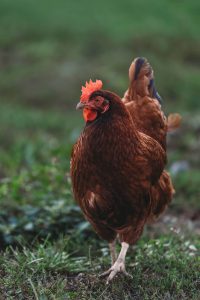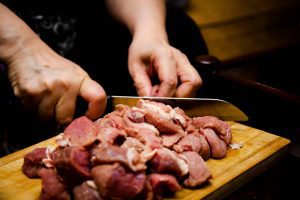Does Bird Flu Affect My Food?
Authors: Umekia R. Taylor, Michael Puglisi, and Heather Peracchio
umekia.taylor@uconn.edu
Reviewers: Indu Upadhyaya, Assistant Extension Educator, UConn Extension and Dennis D’Amico, Associate Professor of Dairy Foods, UConn Animal Science
Publication August 2024 | EXT075
https://doi.org/10.61899/ucext.v1.075.2024
Introduction
Bird flu (avian influenza) has become an increased concern in the health community throughout the United States. Thoughts of the potential risk of contracting the disease from store bought foods prepared and consumed at home are concerning to many consumers. This fact sheet provides information on how to prevent risk from bird flu exposure and how to prepare food properly to ensure food safety.
Definitions and associated acronyms:
- Avian Influenza (AI) which is identified as H5N1
- LPAI (low pathogenic Avian Influenza)
- HPAI (highly pathogenic Avian Influenza)
What is Bird Flu and How Does it Spread?
‘Bird flu’ is the name that has been used to describe a disease caused by the avian influenza virus. It can spread among wild birds, poultry, cattle, pigs, and
other animals. Although uncommon, in a few cases the avian influenza virus has crossed over and caused illness in people. Human infection can occur through contact with bodily fluids or feces (poop) of infected birds or animals, and from touching
surfaces that have been in contact with infected birds or animals.
Farm workers, hunters, and people who handle birds and animals for pets or livestock can be a risk for bird flu. Those who attend agricultural fairs, or visit farms should wash hands thoroughly with soap and water after handling or petting birds and animals. Many areas have placed tighter restrictions on events such as petting zoos to minimize risk.
Proper food safety practices including hand washing and kitchen hygiene reduce the risk and spread of foodborne illnesses, including bird flu.
Thoroughly cooking poultry and meats kills harmful bacteria and viruses. Consuming raw milk can be risky because raw milk may contain viruses and bacteria. Pasteurization, a heat treatment process, effectively kills these harmful viruses and bacteria.
Safely prepared and cooked poultry are safe to eat. Proper food safety practices are important every day. In addition to proper processing, proper handling and cooking of poultry provides protection from viruses and bacteria, including bird flu.
How to Prepare Foods Safely
Remember, follow these four basic food safety steps: CLEAN, SEPARATE, COOK, and CHILL.
- Cook poultry to an internal temperature of at least 165 degrees F;
- Ground beef should have cooked temperature of 160 degrees F;
- Whole cuts of beef should reach an internal temperature of 145 degrees F after resting for three minutes;
- Keep raw poultry and meats separated from cooked foods to avoid cross-contamination;
- Thoroughly wash all surfaces, utensils, and hands after handling raw and cooked foods.
Additional Resources
Center for Disease Control. (2024, July 15). H5 Bird Flu: Current Situation. Retrieved July 15, 2024, from https://www.cdc.gov/bird-flu/situation-summary/
Center for Disease Control. (2022, May 24). Bird Flu in Animal and People: Causes and How it Spreads. Retrieved July 15, 2024, from https://www.cdc.gov/bird-flu/virus-transmission/index.html
U.S. Food and Drug Administration. (2024, May 30). The Dangers of Raw Milk: Unpasteurized Raw Milk Can Cause a Serious Health Risk. Retrieved July 15, 2024, from https://www.fda.gov/food/buy-store-serve-safe-food/dangers-raw-milk-unpasteurized-milk-can-pose-serious-health-risk
U.S. Department of Food and Agriculture. (2015, April). U.S.D.A. Questions and Answers: Food Safety and Avian Influenza. Retrieved July 15, 2024, from https://www.usda.gov/sites/default/files/documents/avian-influenza-food-safety-qa.pdf
The information in this document is for educational purposes only. The recommendations contained are based on the best available knowledge at the time of publication. Any reference to commercial products, trade or brand names is for information only, and no endorsement or approval is intended. UConn Extension does not guarantee or warrant the standard of any product referenced or imply approval of the product to the exclusion of others which also may be available. The University of Connecticut, UConn Extension, College of Agriculture, Health and Natural Resources is an equal opportunity program provider and employer.

